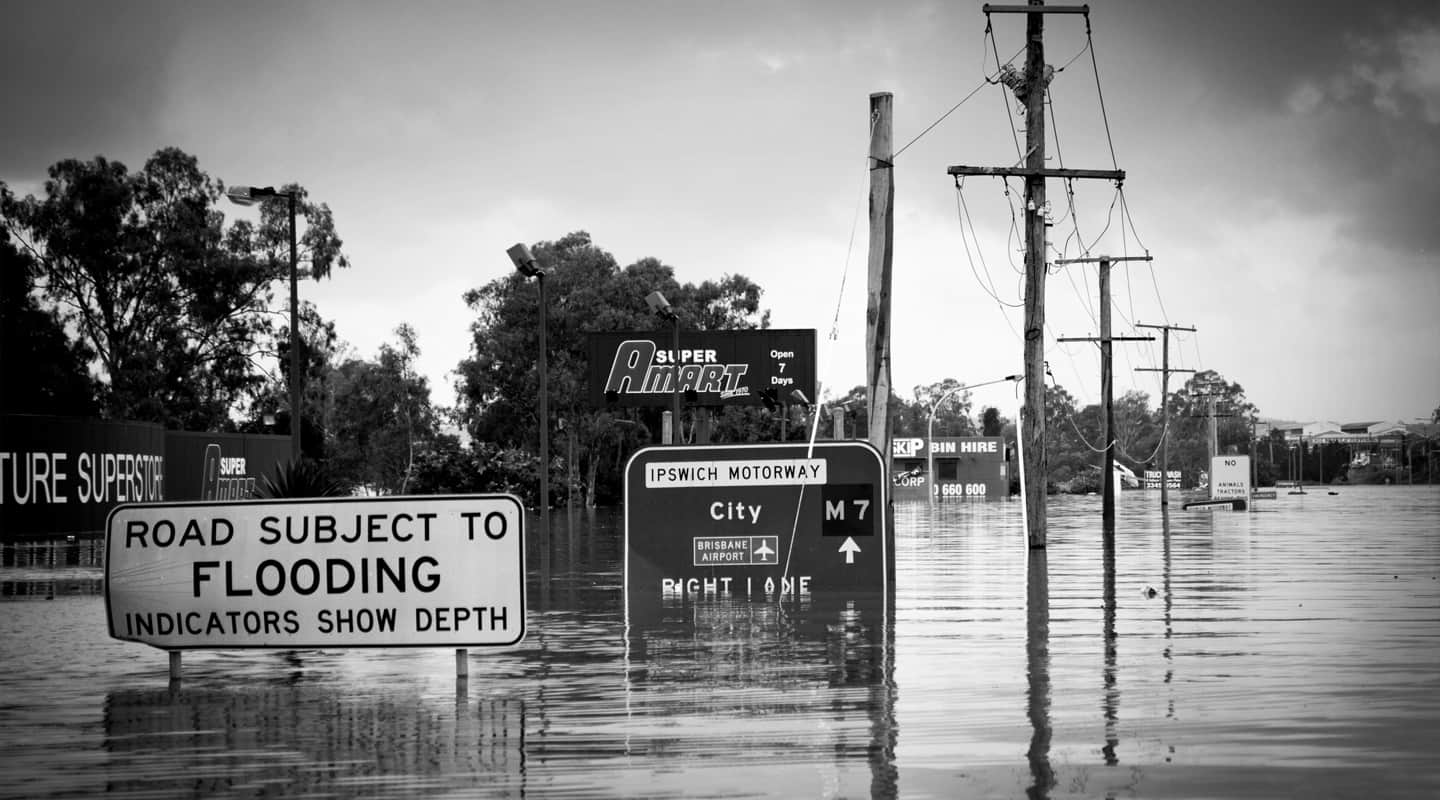
Inundated
In the days after the disaster, AV talked to a number of companies who have borne the brunt of the terrible flooding in Queensland.
Text:/ Lucie Robson
Photo:/ Mervin Chiang
The staff at Advanced Video Integration in Milton arrived at work early on Tuesday January 11 expecting a regular day, but a few hours later were forced to evacuate their premises and send stock away in vans. “Obviously at that point we were not fully aware of how high the water was going to go,” says Business Development Manager Shanelle Stokes. “When we found out later that afternoon that it was expected to rise to the level of the ’74 floods, that rang some alarm bells for us and some of the guys were able to go back to the building and decided to sandbag. We sandbagged but obviously that was completely useless, because by Tuesday night we had our whole bottom floor completely under water.”
At the height of the worst floods in decades, three quarters of the entire state of Queensland was declared a disaster zone. At the time of writing, the death toll was 20, with 12 people still missing. Recovery work will continue for months.
“The damage that was done was largely the disgusting mud that you would have seen on the television – it came through our whole bottom floor,” Ms Stokes continues. “We have lost quite a bit of stock. We didn’t actually have an evacuation plan set up because we had never thought that anything of this magnitude would happen to us.”
SCHOOL’S OUT
Not many people or businesses did. In a flood, often the only thing that can be done is to move costly equipment to higher ground and hope for the best. Darryl Rosin is the team leader of Client Technology Services at Griffith University, where the Southbank Campus, including the Conservatorium, has been shut for days. He says that it’s as yet unknown if equipment was damaged.
“The building was sandbagged, and that prevented any water from entering the building, as far as we know. Some of the AV equipment is in the library area and that gear will need checking – because the rooms have been surrounded by water and without air conditioning for a week, it’s prone to mould infestations. It’s a major problem,” he says.
Mr Rosin says that moving as much equipment as possible to higher ground was a “race against the clock”. But even though the aftermath can be just as terrible, he continues, floods are unique in that there is sometimes enough warning to have proper procedures in place. “Before the floods arrived, the main problem was mould showing up in lots of places, such as people’s houses, and the ongoing fight with that. Floods are different to many sorts of natural disasters because they kind of happen slowly. You have a couple of day’s notice that the flood is coming, it’s not a like a bushfire that comes through or a severe hailstorm, where by the time the word gets out that there’s a problem, it’s all over.”
WORK ON HOLD
For other industry members, damage that could have been catastrophic was averted by a lot of preparation and quick thinking. Greg Fields, General Manager of AVI Corporate in Newstead, says the fact their team had only very minor damage to its equipment was a stroke of luck, considering the building backs onto Breakfast Creek, the main tributary from the Brisbane River. Similar to other affected audiovisual businesses, one of the biggest problems has been the amount of scheduled work that is now on hold.
“It’s an unknown as to how well the big businesses will recover,” he says. “At the end of last year we were starting to see some positive growth, but now everyone’s gone back into recovery mode. In the short term a lot of people will focus on getting things back together, and maybe not on marketing and future events.”
Large entertainment venues in the city such as Queensland Performing Arts Centre, Brisbane Convention and Exhibition Centre (where AVI Corporate staff had jobs planned) and Queensland Theatre Company have suffered water damage in their lower levels and remain closed. However, in these venues as well, forward thinking prevented what could have been catastrophes, with expensive audiovisual equipment moved up to higher levels before the floods waters came through, although the Theatre Company did have permanent under-seating speakers that were damaged by floodwater.
VALLEY HIT HARD
Videopro in the Fortitude Valley, is feeling the effects of a heavily flooded carpark, and no electricity. A number of its retail stores were forced to close and the immediate future is quite uncertain, says Financial Controller Jason Sing.
“All our computer servers here at head office were cut off. We didn’t have any security here either, so we had to get a security guard, which was quite an effort because everyone wanted security guards,” he explains. Staff moved all equipment to a higher level, just in case, but water damage did not eventuate, although the carpark is still under water.
“All our retail stores in Melbourne and the Gold Coast were being affected by the computer servers, so we had to buy some generators, and get them all hooked up,” he continues. “Even then, because of some on-going problems those generators have needed constant monitoring ever since.”
“”
We sandbagged and obviously that was completely useless, because by Tuesday night we had our whole bottom floor completely under water.
DISASTER MANAGEMENT
Haycom Staging in South Brisbane had to relocate all staff and servers to a temporary office to escape the rising water levels. “We had a disaster management strategy, which we activated when we were asked to evacuate the building,” says Ian McManus. “We were very lucky because the water line was about a metre below our warehouse floor. So we didn’t get any equipment damage, however the building’s first floor, the floor below us, is extensively damaged. And unfortunately the power distribution board is there and will have to be rebuilt.”
Unlike other AV businesses in the area, Haycom has been as busy as ever, and have not had to postpone any projects as yet. The Production Shop in East Brisbane also escaped unscathed but director Graeme Hicks says that the business is donating 1% of sales for the next six months to the disaster recovery fund, and hopes that others in the region will do the same.
SMALL BLESSING
Derek Powell, manager of Teacher Technology Support at the University of Queensland, is grateful that the flooding happened during the university holiday period. “As far as damage to the university is concerned, we’re still checking it out at the moment but it seems that probably only a couple of our teaching spaces have been damaged by floods,” he continues. “The university is actually built very sensibly, with its own flood plain around it, which is the playing fields, tennis courts, the swimming pools and parking areas around the periphery of the university, where the river flows. So we didn’t get a whole lot of inundation around any of the teaching areas. The places that did go under are areas like the glasshouses, the research facilities, but we’ve suffered very little damage to the audiovisual infrastructure, that we can tell at this point.”
Over in Toowoomba, where the flooding came with far less warning, much of the CBD was shut down and business at Visual Focus will be slow for some time yet. “The whole town’s been very quiet, everyone is waiting to see what the outcome is going to be and holding their cards close to their chest. Obviously no one is spending any real money at the moment, until they’ve worked out what they’re doing,” says manager Ralph Atkinson.
ASSESSING THE IMPACT
While the inconvenience of delayed building works and power shortages can have lasting effects, the disruption to the lives of Queenslanders themselves is no doubt the worst result of the disaster.
“The toll on some people… they’ve lost everything,” says Darryl Rosin. “I was talking to a colleague today, and his mother lives in an apartment that’s all gone and the state emergency service has just moved in with a front-end loader and started scooping up everything from the apartments. You could see family photos and other valuables falling out. That’s pretty terrible.”
The distribution of damage can seem unfair, remarks Greg Fields, whose businesses premises stayed mostly dry, despite being right in the thick of the flood zone. “Just to see the fact that one side of the street’s right and the other one’s not, one side’s devastated, one’s not. But everyone’s just in there, doing their thing.” Thankfully, there was no shortage of volunteers for the factory clean out, a fact that all the other affected businesspeople have also praised.
“The Queensland spirit shines through.”
Queensland Premier’s Disaster Relief Appeal: www.qld.gov.au/floods/donate.html














RESPONSES